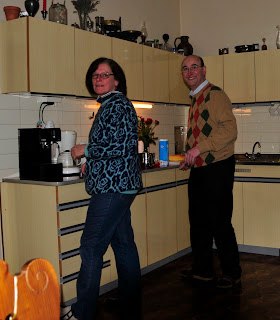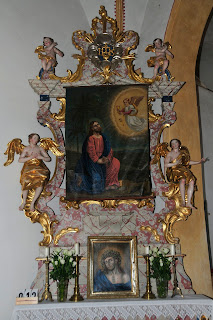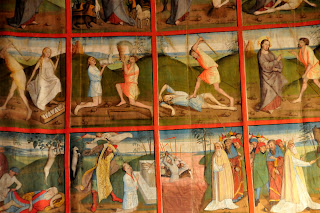Search This Blog
Sunday, March 29, 2009
Sternberg: some more "HUNGERCLOTHS"

Das Kirchlein von Sternberg, steht hoch auf einem Huegel, auf welchem Ausgrabungen
auf eine Besiedlung um 1,500 Jahre befor Christus schliessen lassen.
The little church of Sternberg sits high atop a hill. Excavations there allow the assumption
of this area having been settled about 1,500 years bC.

As many other churches in Carinthia, so hides the Church of Sternberg
its main altar from the congregation's view by hanging a richly decorated,
so-called "Hunger cloth" in front of the main altar.

A closer view of the "hunger cloth".
To see it properly you really should enlarge this image by clicking on it.
Family Pix
Gerhild, my cousin, once removed, or is it: Second cousin...I never know. In any event:
She is the daughter of the daughter of my mother's sister...does that explain it to your satisfaction? In any event, she's a lovely woman, and she says to me:
"You know Bert, all these pictures of the 'hungercloths', and "snow on the mountains", are lovely to look at. But I am waiting for some more family shots."
Well, here they are:
The people involved are: Kordula, Gerhild, Juergen and finally Christin.
Gerhild, die Tochter von der Tochter von der Schwester meiner Mutter, sagt zu mir:
"Weisst du Egbert, diese Bilder auf deinem Blog von den "Hungertuechern" und "Schnee auf den Bergen' sind ja schoen und recht. Ich moechte aber noch mehr Familienfotos sehen.
Naja, hier sind sie: von l nach r : Kordula, Gerhild, Juergen und Christin.
She is the daughter of the daughter of my mother's sister...does that explain it to your satisfaction? In any event, she's a lovely woman, and she says to me:
"You know Bert, all these pictures of the 'hungercloths', and "snow on the mountains", are lovely to look at. But I am waiting for some more family shots."
Well, here they are:
The people involved are: Kordula, Gerhild, Juergen and finally Christin.
Gerhild, die Tochter von der Tochter von der Schwester meiner Mutter, sagt zu mir:
"Weisst du Egbert, diese Bilder auf deinem Blog von den "Hungertuechern" und "Schnee auf den Bergen' sind ja schoen und recht. Ich moechte aber noch mehr Familienfotos sehen.
Naja, hier sind sie: von l nach r : Kordula, Gerhild, Juergen und Christin.
Visiting in Feistritz on the Drau
Monday, March 23, 2009
Jeffery Broussard & the Creole cowboys

This group from Luisiana plays up a storm of melodies and rhythm
that penetrates your body and forces you to swing along.
Superb musicians, one and all, they present a mixture of R & B together
with a style, all their own, called Zydeco.

from left: Classie Ballou Jr. (bass guitar and background vocals)
Greg Gordons ( drums )
Saanen Kerson, (scrubboard and accordeon)
Jeffery Broussard (accordeons and vocals)
D'Jalma Garnier III, ( guitar )
The Jaun Valley of Carinthia - Das Kaerntner Jauntal-
The Hunger Cloths of Stein in the Jaun Valley
More "Hunger cloths" in Stein in the Jaun valley. .Mehr Hungertuecher in Stein im Jauntal.
Sunday, March 22, 2009
Christin with Pinta and Santa Maria
Christin's best friends of the four legged variety.
Christins beste vierbeinige Freunde
Left: Santa Maria, Right: Pinta
At the start of the Stations of the Cross.
Am Anfang des Kreuzweges.
At an old country church,
with very modern Stations of the Cross
Wednesday, March 18, 2009
The Hunger cloths - Die Hungertuecher
Um die folgenden Bilder, besonders jene der Hungertuecher, richting zu sehen MUSS man
auf das jeweilige Bild klicken, um es gross zu sehen...
In order to fully appreciate the pictures of the Hunger Cloths, one MUST click on each respective image in order to view it in the large format.
auf das jeweilige Bild klicken, um es gross zu sehen...
In order to fully appreciate the pictures of the Hunger Cloths, one MUST click on each respective image in order to view it in the large format.
Tuesday, March 17, 2009
Das "Fastentuch" oder "Hungertuch. / The Hunger cloth...
Das "Fastentuch", auch "Hungertuch" genannt, wird in vielen Roemisch Katholischen Kirchen, besonders in Tirol und Kaernten, waehrend der Fastenzeit, vom Aschermittwoch bis zum Karsamstag, vor dem Hauptaltar befestigt. Viele dieser Tapeten, kunstvoll mit Stickerei oder Malerei verziert, stammen aus dem 13. oder 15. Jahrhundert. Andere sind jedoch aus modernster Zeit. Viele dieser Tuecher bestehen aus mehreren ( bis 90 +) Teilen, welche mit Farbenfreude das Leiden Christi den damaligen Illiteraten erklaerten.
The "Hunger Cloth" is displayed in many Roman Catholic churches mounted in front of the main altar. This custom is particularly ingrained in Carinthia and Tirol, where the Cloth hides the main altar between Ash wednesday and Palm Sunday. Many of these tapestries are beautifully decorated either by painting or by needle work. Some date back to the 13th or15th century, while others are very new. The old ones feature up to 90 panels depicting the suffering of Jesus Christ.
The "Hunger Cloth" is displayed in many Roman Catholic churches mounted in front of the main altar. This custom is particularly ingrained in Carinthia and Tirol, where the Cloth hides the main altar between Ash wednesday and Palm Sunday. Many of these tapestries are beautifully decorated either by painting or by needle work. Some date back to the 13th or15th century, while others are very new. The old ones feature up to 90 panels depicting the suffering of Jesus Christ.
Monday, March 16, 2009
Die Wehrkirche von Diex / The walled church of Diex
The "Hungercloth" of Hainburg

Die Kirche von Hainburg mit dem beruehmten, aus dem 15. Jahrhundert stammenden
"Fastentuch" oder auch "Hungertuch" genannt.
The church of Hainburg with the famous "Hunger cloth" from the 15th Century.

Das Hungertuch verdeckt beinahe den ganzen Hauptaltar.
The Hunger Cloth covers almost all of the main altar.
Subscribe to:
Comments (Atom)

































